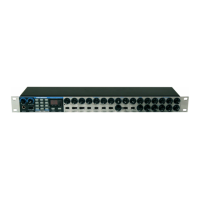Advanced features
Imagine a String section of eight violin players. With the LFO
locked and the LFO being used to create a vibrato. All eight
of the string players would have the bow in exactly the same
position. This obviously does not occur in a real string section
and if it did the sound would be very unusual. In reality each
player’s bow would be in a different position which gives the
strings a ‘chorus’ type sound. To simulate the string section the
LFOs would not
be locked.
Key Synchronization.
Each LFO may be restarted every time a key is pressed.
For example, if a siren type sound effect was required, an LFO
using a sawtooth wave would be set to positively modulate
pitch. Each time a new key is pressed the pitch would climb
from the same point rather than being at an undetermined pitch
position.
Changing LFO1 and LFO2 Locking and Key Sync
Repeatedly press KEY 0 (ensure function switch is in shift
mode) until the display shows L 1 (for LFO1) or L 2 ( for LFO 2)
and an alternating symbol. The table opposite illustrates the
options according to the letters displayed. Use the PORTA /
DATA knob to change the mode.
LFO1 and LFO2 Midi Clock Synchronization
Both LFOs may be locked to MIDI Clock. As an example, a
very pleasing audio effect may be achieved when an LFO is
modulating the filter cut off frequency and this is synchronized
to the tempo of amusical piece.
To synchronize an LFO, repeatedly press KEY 0 (ensure the
function switch is in SHIFT mode) until the display shows y 1
(for LFO 1) or y 2 (for LFO 2) and an alternating value. Rotate
the PORTA/DATA knob until the desired musical timing value is
displayed according to the table on Page 27.
This works in a similar way to Delay sync. Refer to Page 26 for
information on how to set this up for use with an external
sequencer or computer.
51

